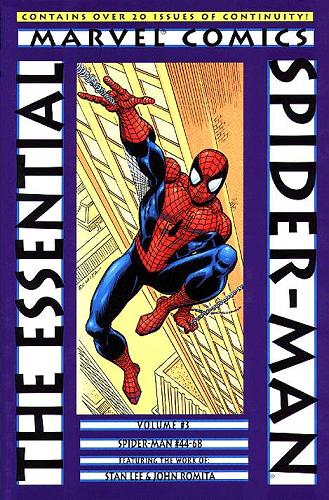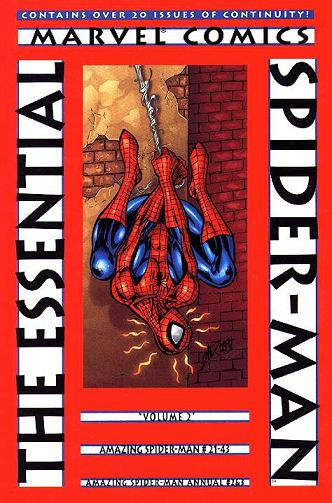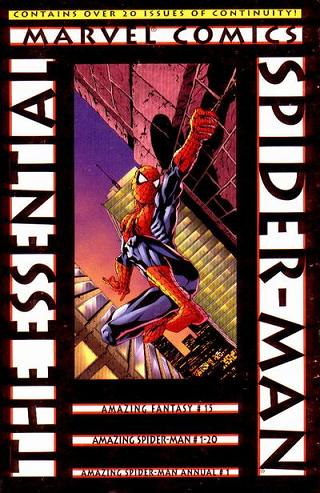
Essential Fantastic Four Vol. 2
Stan Lee, Jack Kirby and friends
Reprints: Fantastic Four #21-40 and Annual 2 (December 1963 – July 1965)
Get this for: Lee and Kirby gathering steam — Five stars
The second volume of Essential Fantastic Four opens with a story that should not work, but does. The Fantastic Four fight a new villain, the Hate-Monger, who is stirring up race hatred, class hatred and religious hatred throughout the country and even manages to set our heroes against each other. Which is bad luck for Nick Fury, who needs them to stop the rebellion in San Gusto which the Hate-Monger is also behind, but with a bit of trickery he manages to get all the bickering members to the little South American country. Of course they manage to defeat the Hate-Monger in the end, overcome their differences and reveal who he really is: Adolf Hitler. Even in 1963 this was corny as hell, but somehow Jack and Stan manage to make it work.
It’s a good example of their growing power as storytellers both individually and as a team. In the first twenty issues of Fantastic Four they were finding out what did and did not work, with some misfires along the way and here they’re building on that foundation. The basics are in place, they know who the characters are, what they can and cannot let them do, how they react to a given situation. Was for e.g the Thing in the first volume still a figure of menace, somebody who could erupt at any moment and become a true monster rather than just looking like one, here he has mellowed to still grumpy but essential loveable, still inclined to lash out in anger, frustration or irritation but never with the intent to hurt anyone. Mr Fantastic in the same way has evolved from the brainy, detached scientist to somebody with deep seated passions normally kept hidden, who scares even his team mates and friends when these passions are unleashed.
Villains too get more multidimensional, with both Doctor Doom and the Submariner becoming more sympathetic in the process. The latter was always more an antihero than a real villain and his own moral code is developed further here, to the point where the Fantastic Four end up fighting alongside him against the menace of a real underwater tyrant, Attuma. Doom on the other hand never becomes an ally of the Fantastic Four, but is made a tragic figure through his origin, told in the second Fantastic Four Annual. It turns out he’s a gypsy, whose mother was killed when he was still a baby and whose father died fleeing for his life from a local baron when he was a small boy. He swears vengeance, starts studying the black arts of his mother, as well as educating himself into science (no finer distinction really necessary in an universe in which a biochemist can create a malevolent artificial intelligence from scratch), gets a scholarship at the same university as Reed Richards and Ben Grimm, tries to contact the netherworld and gets blown up, is thrown out, travels the world and ends up with a mysterious sect of monks in Tibet and becomes Dr Doom. Even the Skrulls when turning up again turn out not to be all bad.
The stories in this volume are in essence midway between the realive realism with which the Fantastic Four started out and the wild, unrestrained imagination Kirby especially would bring to the title in its more mature years. The stories are based around some supervillain or other menace threatening the team or the world or both and the Fantastic Four defeating it. There’s a healthy dose of soap opera as well, revolving around the Thing and his desire to become Ben Grimm again, become human again and his fear that this will mean losing Alica Masters, his girlfriend, as well as around Mr Fantastic and the Invisible Girl and the love they share but are afraid to speak out. The Invisible Girl at the same time also evolves both in power and personality, getting to be a somewhat less stereotypical comics girl, though still vulnerable to being a professional hostage at times.
On the art front, Kirby’s art gets wilder, more experimental, as he integrates photographic backgrounds in his art, develops ever more baroque looking weaponry, vehicles and scientific equipment. His figures and the way they stand and move gets more exagerrated too, underscoring the theatricality of many of Stan Lee’s scripts. The effect of reading a concentrated dose of Kirby art is, as I’ve mentioned before that I start seeing those Kirby Poses and Kirby Figures in real life. Watching sport is especially good for this…
As good as the first volume of Lee/Kirby Essential Fantastic Four was, this volume was better. One of those times when essential is no hyperbole, but the honest truth.




